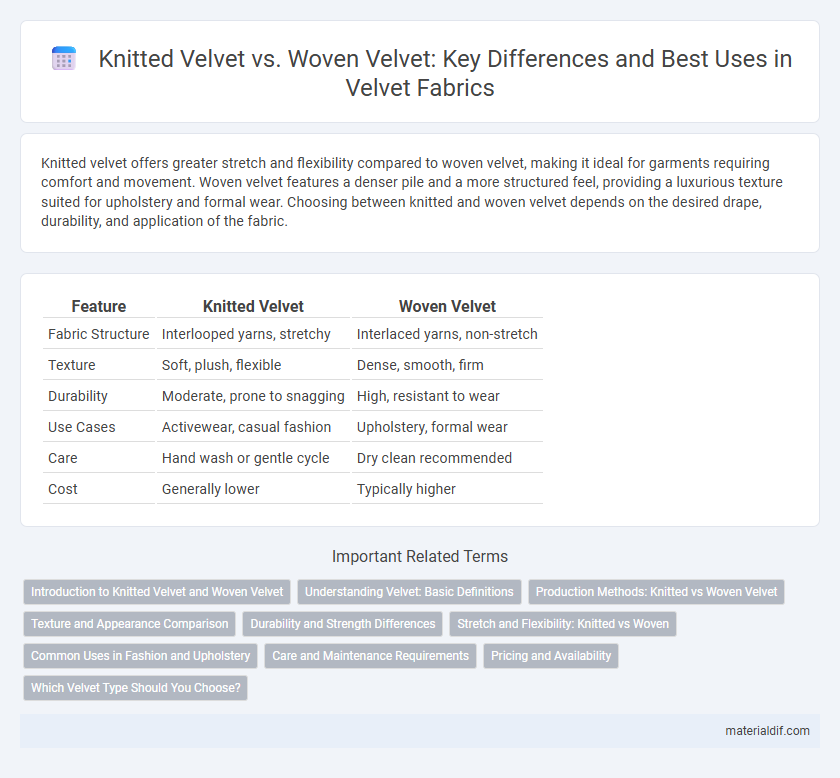Knitted velvet offers greater stretch and flexibility compared to woven velvet, making it ideal for garments requiring comfort and movement. Woven velvet features a denser pile and a more structured feel, providing a luxurious texture suited for upholstery and formal wear. Choosing between knitted and woven velvet depends on the desired drape, durability, and application of the fabric.
Table of Comparison
| Feature | Knitted Velvet | Woven Velvet |
|---|---|---|
| Fabric Structure | Interlooped yarns, stretchy | Interlaced yarns, non-stretch |
| Texture | Soft, plush, flexible | Dense, smooth, firm |
| Durability | Moderate, prone to snagging | High, resistant to wear |
| Use Cases | Activewear, casual fashion | Upholstery, formal wear |
| Care | Hand wash or gentle cycle | Dry clean recommended |
| Cost | Generally lower | Typically higher |
Introduction to Knitted Velvet and Woven Velvet
Knitted velvet features a soft, stretchy texture created by interlocking loops of yarn, resulting in a flexible fabric ideal for comfortable clothing and upholstery. Woven velvet is produced through a weaving process where two layers of fabric are woven simultaneously, creating a dense pile with a luxurious, smooth finish often used in formal wear and draperies. Both types exhibit unique tactile qualities and construction methods influencing their durability, stretch, and overall aesthetic.
Understanding Velvet: Basic Definitions
Knitted velvet features a looped construction made from interlocking yarns, resulting in a stretchy and breathable fabric ideal for comfortable apparel. Woven velvet is produced by weaving two layers of fabric simultaneously and cutting them apart, creating a dense, luxurious pile that offers rich texture and durability. Both types differ significantly in production methods and fabric performance, influencing their suitability for fashion and upholstery applications.
Production Methods: Knitted vs Woven Velvet
Knitted velvet is produced by looping yarns together using knitting machines, creating a stretchable fabric with a soft, plush surface ideal for garments requiring flexibility. Woven velvet is crafted by interlacing warp and weft yarns on a loom, forming a dense pile through a complex cutting process that results in a more structured and luxurious texture. The production difference directly impacts durability and drape, with woven velvet offering superior strength and a smoother feel, while knitted velvet excels in comfort and elasticity.
Texture and Appearance Comparison
Knitted velvet features a stretchy, plush texture that offers a soft, flexible feel, enhancing comfort and drape in garments. Woven velvet, on the other hand, has a denser, more structured surface with a luxurious sheen and a slightly firmer hand, making it ideal for formalwear and upholstery. The distinct looped knit construction of knitted velvet results in a less uniform pile compared to the smooth, consistent pile of woven velvet, affecting both visual depth and tactile richness.
Durability and Strength Differences
Knitted velvet offers greater stretch and flexibility due to its looped yarn structure, which can lead to reduced durability under heavy wear compared to woven velvet. Woven velvet features tightly interlaced warp and weft yarns, providing enhanced strength and resistance to abrasion, making it more suitable for upholstery and high-traffic applications. The denser construction of woven velvet maintains pile integrity longer, resulting in superior longevity over knitted velvet fabrics.
Stretch and Flexibility: Knitted vs Woven
Knitted velvet offers superior stretch and flexibility due to its interlooped construction, allowing greater freedom of movement and comfort in garments. Woven velvet, created through interlacing threads, tends to be less stretchable and more structured, making it ideal for formal or tailored pieces. The inherent elasticity of knitted velvet makes it preferable for activewear or designs requiring dynamic fit.
Common Uses in Fashion and Upholstery
Knitted velvet is commonly used in fashion for creating stretchable garments such as dresses, tops, and activewear due to its flexibility and softness, providing comfort and a flattering fit. Woven velvet is preferred in upholstery and high-end fashion like jackets and evening gowns because of its structured form and luxurious texture, offering durability and a rich appearance. Both types serve distinct purposes, with knitted velvet excelling in casual wear and woven velvet dominating formal apparel and home furnishings.
Care and Maintenance Requirements
Knitted velvet offers greater elasticity and comfort but requires gentle washing and low heat drying to prevent stretching and fiber damage. Woven velvet demands more delicate handling, including dry cleaning or cold-water hand washing, to maintain its pile integrity and avoid crushing. Proper storage with minimal pressure and avoidance of direct sunlight prolongs the lifespan of both knitted and woven velvet fabrics.
Pricing and Availability
Knitted velvet typically costs less than woven velvet due to simpler production techniques and higher material efficiency. Woven velvet, known for its durability and luxurious texture, is often more expensive and less readily available in retail markets. Buyers seeking budget-friendly options can find a wider selection of knitted velvet fabrics both online and in stores, while woven velvet is usually stocked by specialty fabric suppliers.
Which Velvet Type Should You Choose?
Knitted velvet offers greater stretch and flexibility, making it ideal for form-fitting garments and activewear, while woven velvet provides a more structured and luxurious texture suited for formal attire and upholstery. Knitted velvet's breathability enhances comfort for casual wear, whereas woven velvet excels in durability and a rich, dense pile for elegant designs. Choosing between the two depends on the desired garment functionality, comfort level, and the aesthetic effect you want to achieve.
Knitted Velvet vs Woven Velvet Infographic

 materialdif.com
materialdif.com